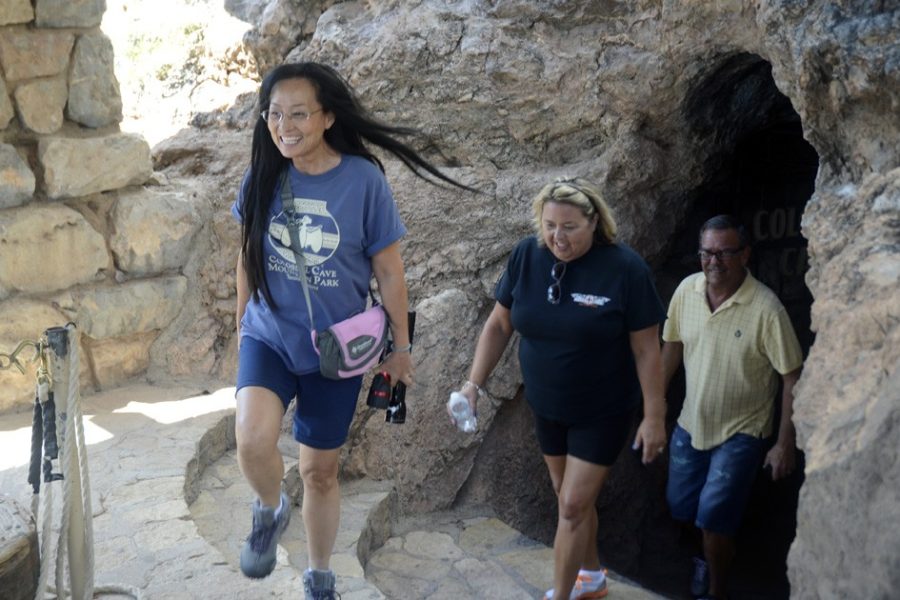With an away game leaving Arizona Stadium deserted this weekend, Friday and Saturday may see an influx of bar-goers and house parties. But there’s more to Tucson than Fourth Avenue and University Boulevard, and some students may find a hike through a dark cave the perfect hangover cure.
For students looking for activities beyond the confines of the campus area, Colossal Cave Mountain Park and Kartchner Caverns State Park promise an adventure through what Rich Buherer, lead guide at Kartchner Caverns, refers to as “a mystical world.”
Colossal Cave Mountain Park is 29 miles southeast of campus and spans over 2,000 acres, an area that includes museums, historic ranches, hiking trails and picnic areas. The main attraction, however, is the cave, said Park Director Martie Meirhauser.
“It’s got to be the primary drive,” Meirhauser said of the cave. “It’s something we’re very proud of.”
Colossal Cave is ranked as one of the largest dormant caves in the world and the ranch dates back as far as the 1870s, which, according to Meirhauser, brings a deeper historic and educational value to the entire park.
“We’re on the national register of historic places, the entire park as a whole, because of the wonderful array of history we have here,” Meirhauser said.
In addition to providing daily access to the caves, the park offers tours like the Wild Cave Tour that hold a larger attraction for UA students, Meirhauser said. These tours are physically demanding and require a reservation in advance, but offer the chance to explore unlit, unmarked passageways in Colossal Cave.
“Those are really for people who crave more adventure,” Meirhauser added. “Our mission is that everything is educational, one way or another.”
Forty miles beyond Colossal Cave Mountain Park is Arizona State Parks-owned Kartchner Caverns. In juxtaposition to the dormant cave at Colossal Cave Mountain Park, Kartchner Carverns features two underground galleries that are very much alive, according to park visitor and cave enthusiast Nate Evans.
“It’s a living cave; you can actually see the moisture on it,” Evans said following a tour on Wednesday. “Other places are dead, but this one is actually still growing and living.”
Former UA students Gary Tenen and Randy Tufts discovered the caves at Kartchner Caverns in the winter of 1974. The caves remained their best-kept secret until 1988, when the state of Arizona purchased the property and decided to open it to the public.
“They wanted to keep it a secret,” said Buhrer. “If they started talking about the secret cave down in Benson, it wouldn’t be a secret for very long.”
According to Buhrer, the two students worked carefully to ensure that as much of the cave was preserved as possible. Almost 40 years later, the caverns remain 80 percent untouched and still have a close relationship with the university. Departments all over campus continue the work started by Tenen and Tufts and continue to make advancements that will prove useful to the entire university.
“Students should come and see what other departments at their school are responsible for and be proud of that,” said Assistant Park Manager Brent Smith. “They should take some pride and partial ownership because they’re helping to preserve, conserve, study, etcetera.”
Kartchner Caverns, Buhrer said, is rated among the world’s top 10 caves for scientific study and is the only living cave that allows public entry.
“The tour guides do a good job of impressing upon you how rare these kinds of caves are,” said park visitor Becky Evans. “It’s a privilege, not a right.”
These protective measures allow guests access to a sight that brings in not only the state population, but also visitors from all over the world,” Smith said.
“It’s one of the jewels in the state park system,” he added. “The colors, the formations that are throughout the cave are pretty spectacular … It appeals across the board.”
The caverns offer tours daily inside two underground galleries — the “Throne Room” and the “Big Room.” Each chamber is over the length of a football field and measures more than 100 feet deep.
Both are filled with an array of geological formations, and the Throne Room is home to the largest column in Arizona, which stands at 58 feet tall named is named Kubla Khan.
“It’s really well preserved,” said park visitor Karl Holderbein, 23. “It’s not really touristy; it’s very personal.”
Buhrer encourages students at the UA to visit the caverns regardless of their area of study, especially with the current generation’s focus on sustainability.
“College students today have a lot more appreciation for the environment than in the past,” Buhrer said. “I think anybody that’s in any type of field of geology by nature will enjoy it and even those in art — that’s natural art. That’s Mother Nature creating those features, and it’s beautiful.”
Both parks continue to work to preserve their caves and encourage students in particular to leave their comfort zone and see what lies beyond campus grounds.
“It’s okay to leave Fourth Avenue,” Smith said. “There’s a whole world out there to see.”









